Default View
When you enter a video project it will be on the default view. The default view is currently different than our other project types which are defaulted to the card view look and feel.

The project name (Coffee Routines Survey in this example) is located on the top left of the default dashboard view page. To the right of the project name in parentheses is the number of entries submitted to the project so far (9 Results). When you run a filter, the number of results may change as it will update to match the number of entries that fit your filtering criteria.
Task 1: You will see numbers next to each question in your project. In the example below the 1. was the first task asked to participants: Help us put a face to the name! Capture a 30-60 second video and share a bit about who you are. You can click the play button to watch the video, or see the transcription to the right of it.
Task 2: On Single Choice, Range, and Multiple Choice questions you will see a report that you can hoover over to see what was selected by participants. In this example, Caitlin selected she has 4 cups of coffee per day. You can also click the View Reports button to view the report in a larger format.
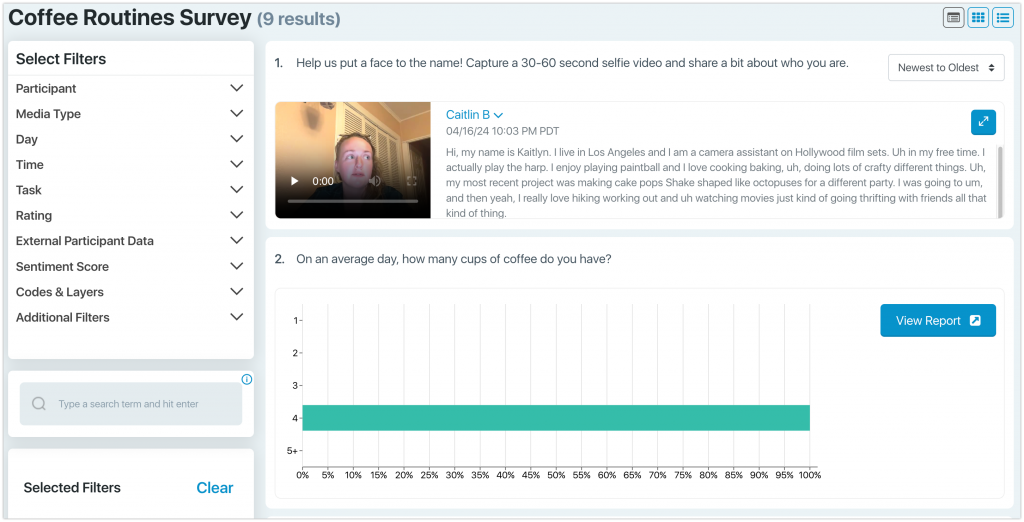
If you have added External Participant Data to participants, you can click the persons name and it will be shown.

Individual Entry
If you want to expand an entry simply click the blue expand button on the top right. When you expand you will be taken to this view:
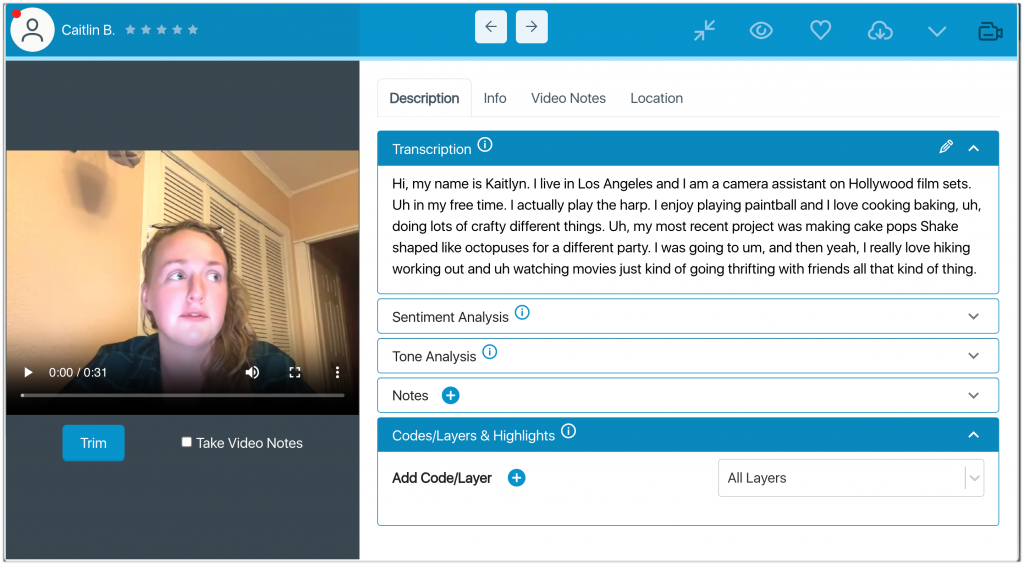
Profile Picture: The Top left of the card will show the participants profile picture if they added one. Typically in diary studies and other use cases we ask participants to include one, but rarely do in surveys.
Participant Name: The participants’ names can be found at the top of the card next to the right of their profile picture in the format first name, last initial.
Viewed Icon: The view or eye icon is located in the top right of the card. When clicked, it will turn the top of the card blue to indicate you have already viewed this entry. You will only see the card being blue if you change to card view. This is helpful as it lets you know which entries you have already analyzed.
Star Rating: Moderators have the ability to give each entry a 1-5 star rating. The star rating field is shared amongst moderators. E.g., If one moderator gives an entry 5 stars, other moderators in the project will see it as 5 stars. If another moderator changes it, it will be changed on all moderator accounts.
Codes: Codes are used to sort data for analysis purposes.
Notes: The notes icon will turn blue when a moderator leaves a note within the entry. You can hover over the notes icon to see how many notes have been left by moderators. If you click the notes icon, you will be brought into the expanded view of the entry where notes are displayed.
If you want to change your settings for expanded entries, you do so by clicking your avatar in the top right and then clicking the “Project Settings” tab. By changing these settings, you can have all areas of an expanded collapsed by default or only specific areas. In the screenshot below, the moderator has the Transcription & Codes/Layers & Highlights auto expanded.

When you expand an entry, the media or response submitted by the participant will be on the left. Media can be expanded further by clicking the icon in the bottom right. Videos can be trimmed by clicking the Trim button. Move the left and right ends of the slider to set the beginning and end of the video clip you want to take. You can then download the trimmed video by clicking the download button.
To the right of the media or response are several different tabs. The Description tab has several different pieces of information about the entry.
Transcription: Video and Audio entries will automatically be transcribed. You can edit transcriptions by clicking the pencil icon. Once a transcription is edited and saved, the Sentiment and Tone analysis will run again. You will need to refresh the page on your browser to see the change.
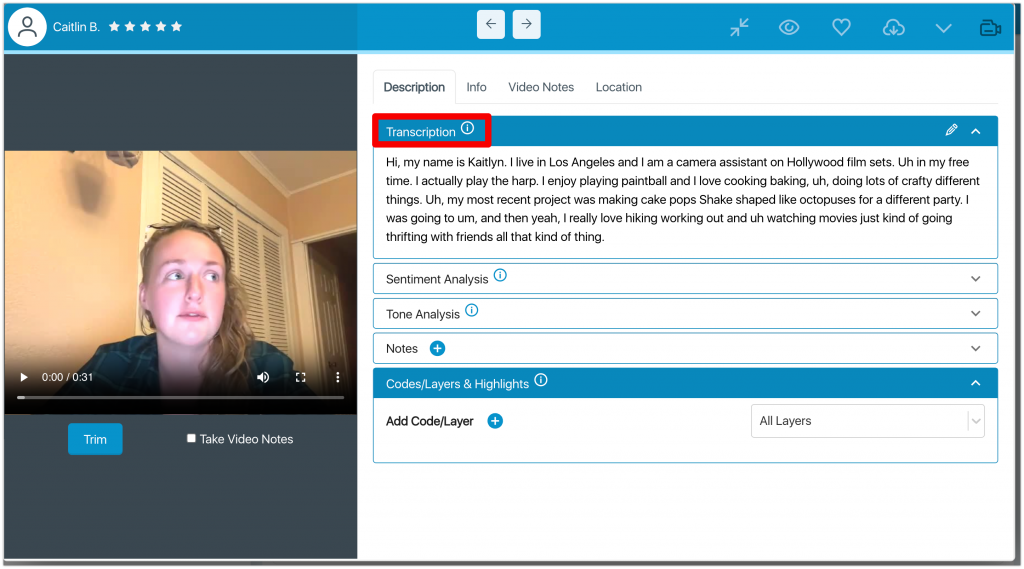
Sentiment Analysis: Sentiment analysis is either run on the transcription of video and audio entries, or on the description left by participants on other entry types. Sentiment scores fall on a range of -1 to 1 with -1 being the most negative, 0 being neutral, and 1 being the most positive. Neutral entries will have a score of 0, negative entries will have a score from 0 to -1, and positive entries will have a score from 0 to 1. You can hover over individual sentences to see the sentiment score for that sentence. If you edit the transcription or description and refresh the page, it will recalculate the sentiment score. Sentiment is not run on Picture or Heat Map question types.
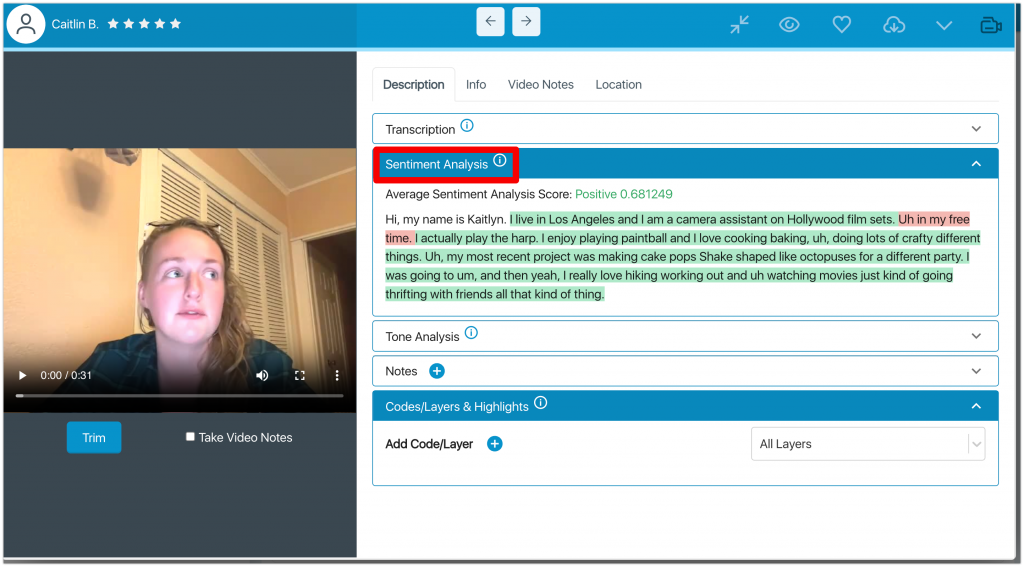
Tone Analysis: The tone analysis engine detects anger, disgust, fear, joy, or sadness conveyed at the entry level. Tone analysis is run on the transcription of audio and video files, and on open-end text tasks, it is run on the text; and on single-choice, multiple-choice, and range questions, it is run on the open-end follow-up question (if you include one). Tone is not run on Picture or Heat Map question types.

Notes: Moderators can leave notes for themselves and other moderators in the notes area. Notes are viewable by any moderator that opens the dropdown. You can see a list of notes added across all entries in the Moderator Note Feed within the Admin dropdown.

Codes/Layers & Highlights: Codes allow moderators to mark entries for sorting and analysis purposes. Layers are groups of codes. In the platform, you have a few ways of coding. The first way is to click the circular + sign in the Codes/Layers & Highlights section.

When you click, you will get a popup like the one shown below. The example popup has many different layers and codes already made for this project. Our layers are Default, Accessories, Brands, Inside, and Outside. If this is the first time you are coding in your project, you will only have the “Default” layer. If you ever want to add or remove a layer, click the “MANAGE LAYERS” icon.
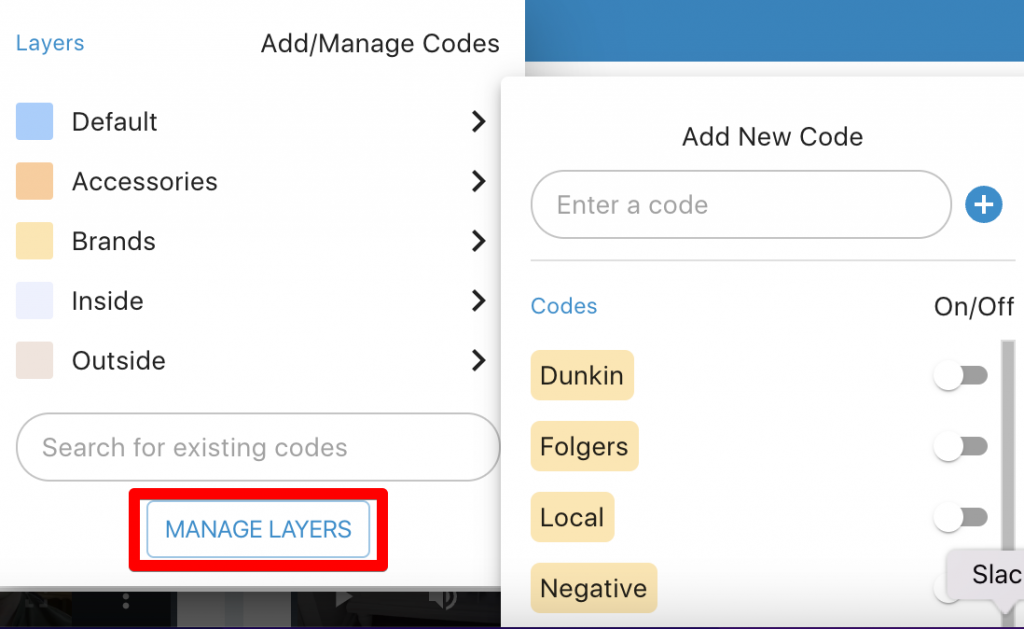
If you want to add a code to a layer, you would click > to the right of the layer you want to add a code to. For this example, we are adding a code to the Default Layer. You would add the code in the Enter a code box in the second popup. In the example below, I typed “Cream & Sugar.” You would hit Enter on your keyboard to submit this as a code or click the blue + icon.
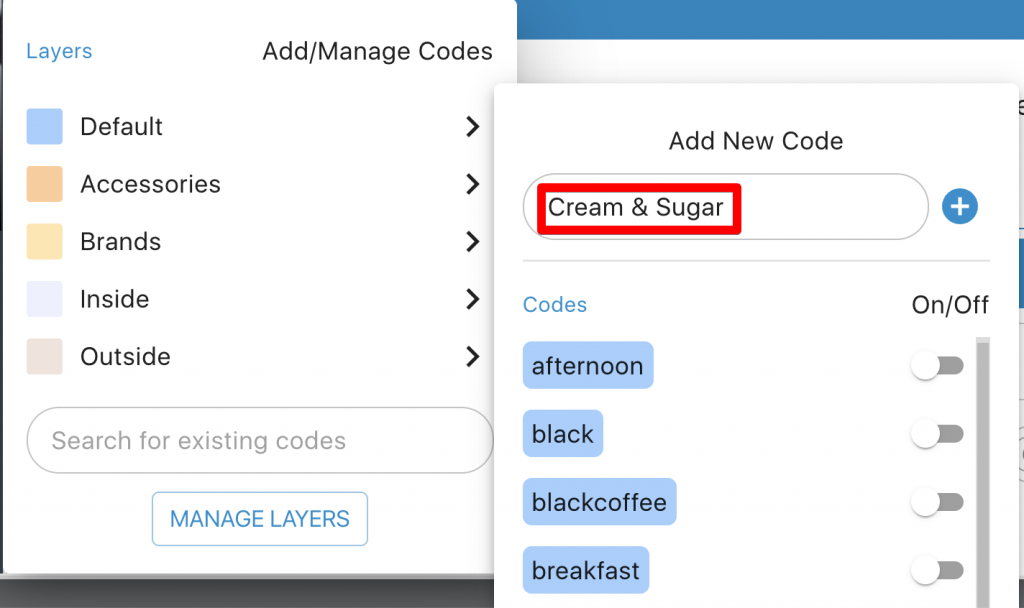
Once submitted, you will see it in the list for that layer. When the radio button is blue (like in the picture below), the code has been applied to this entry. You can toggle codes on and off by clicking the radio button with your mouse.
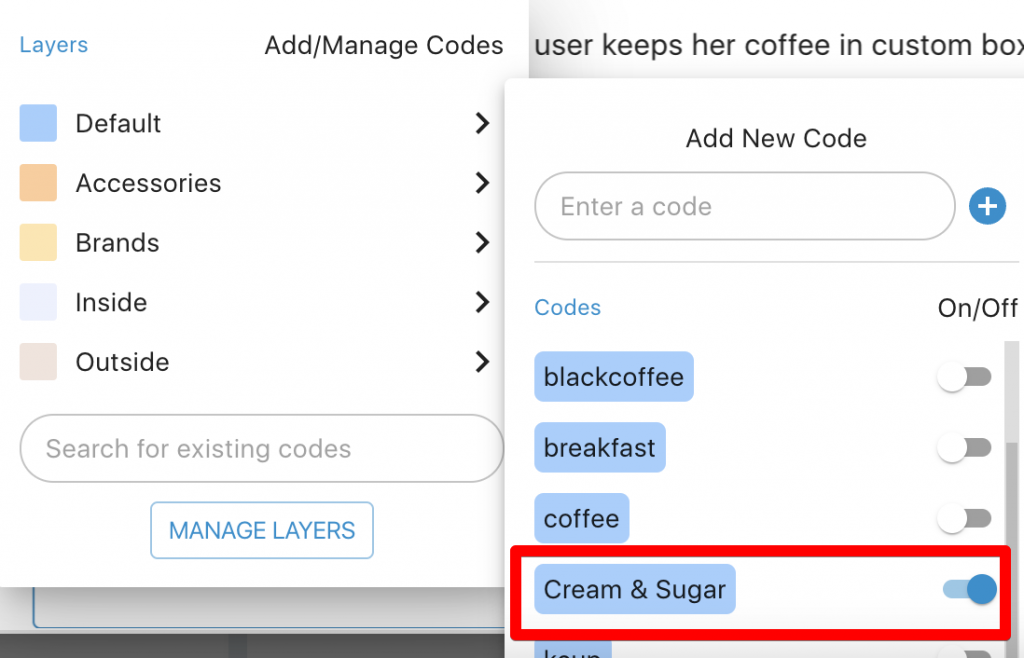
If you exit the popup, you will see all the codes applied so far. All codes used via this method will always have a “0” before the words. So in the case of the code we just created, it says 0 Cream & Sugar. You will see that a second moderator was the one who added the “Cream & Sugar” code in the picture below. If you decide you don’t want this code, you can click the circular X button to the right of the word to remove it.

The other way to code is to highlight text in the Open End Text field, or the Transcription. In the screenshot below, I highlighted the words, “hot cocoa”. Once I stopped highlighting, I got the popup where I could now code this set of words or sentences.
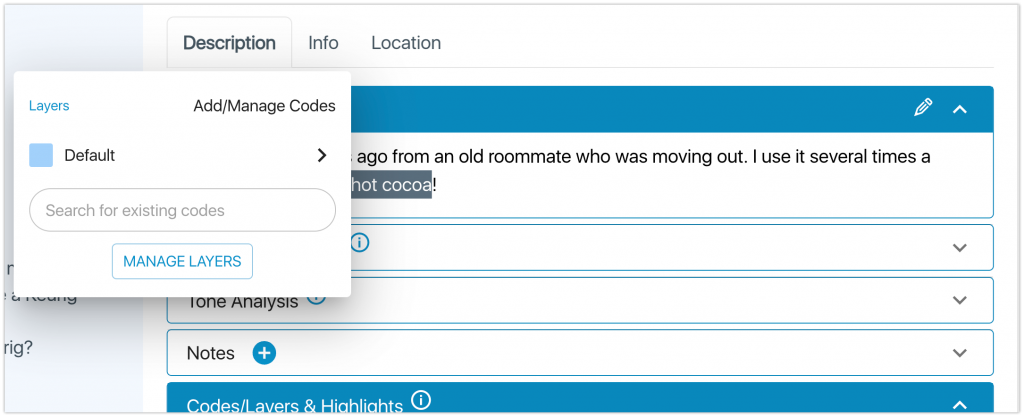
I then coded this sentence as “Hot Cocoa” shown below.
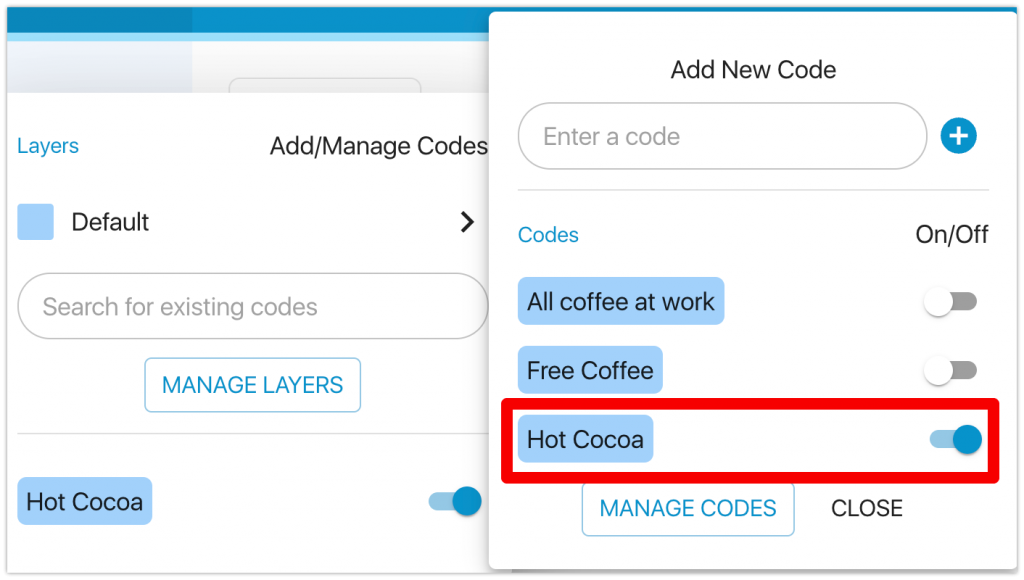
After you click away from the popup to close it, the words or phrases will be highlighted in the color of that layer. In the screenshot below, you will see our phrase is in the blue color that was a part of the “default” layer.
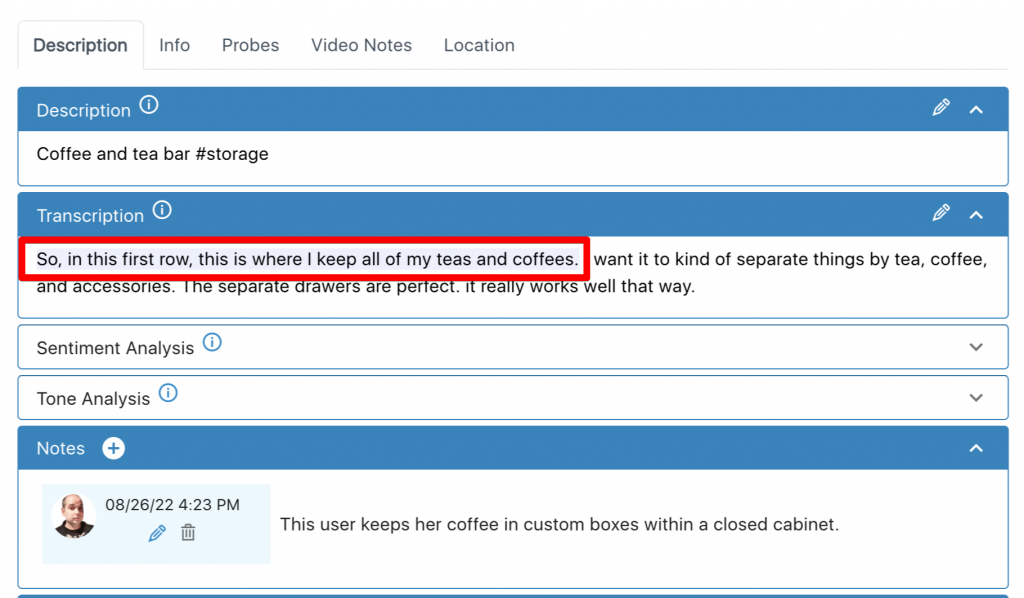
If I click off the popup, I will see “Kitchen” has been added and has a “1” next to it. The 1 indicates that this entry has been highlighted as a code 1x so far.
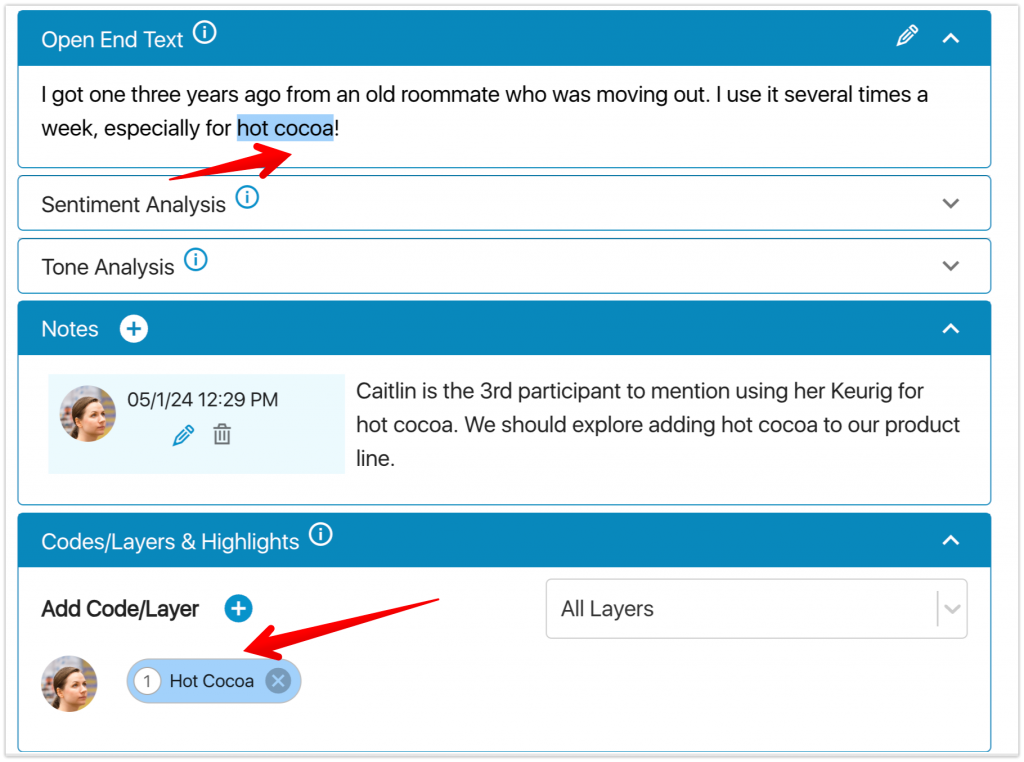
If you click the word “Hot Cocoa” you will get a popup:

Upon clicking the icon that the red arrow is pointing to, you will be shown the area highlighted in gray, allowing you to remember the phrase you coded.

Info Tab: This tab provides the underlying details of the entry, including the participant’s name, when the entry was submitted (created), the participant’s time zone, the task title, the task instruction, and task media if it’s present. Task media is the media added to a task by the moderator, and you can click on it to view it. This can be a picture or a video.
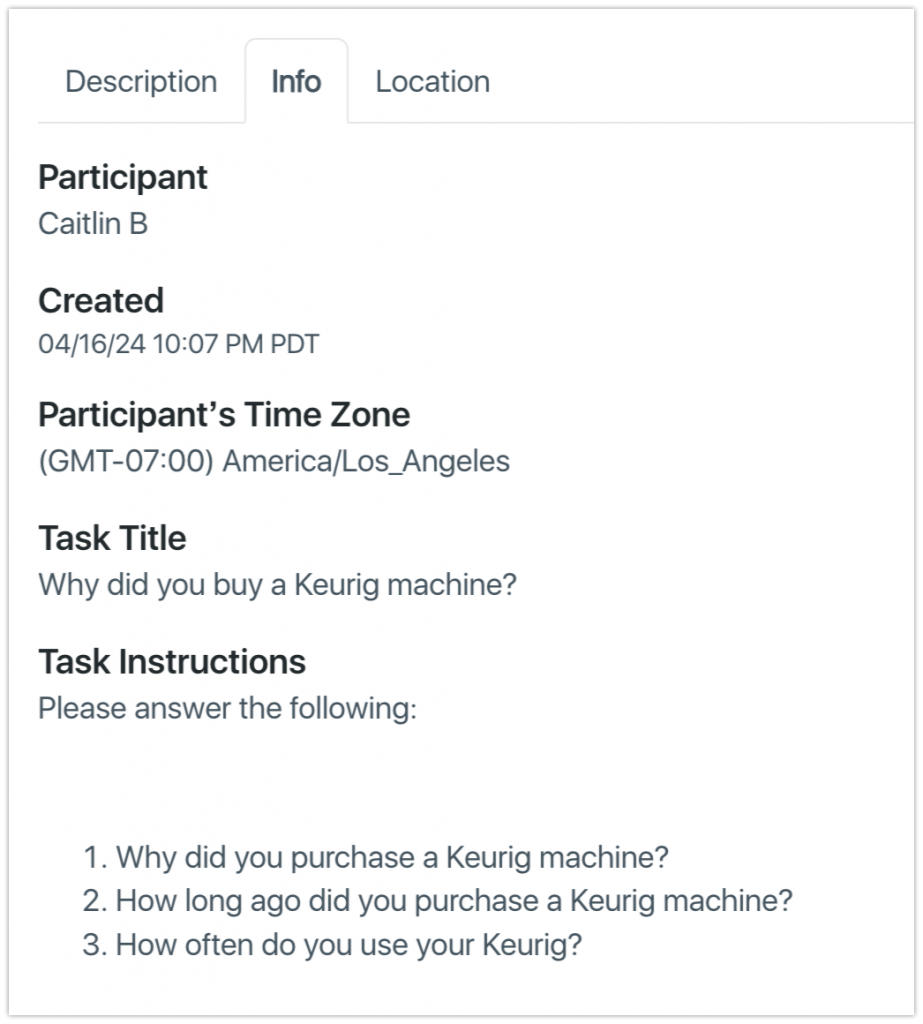
Video Notes: The video notes functionality is available on video recordings. To view the tutorial on Video Notes, please visit this page: https://helpcenter.ethosapp.com/desktop-video-notes/
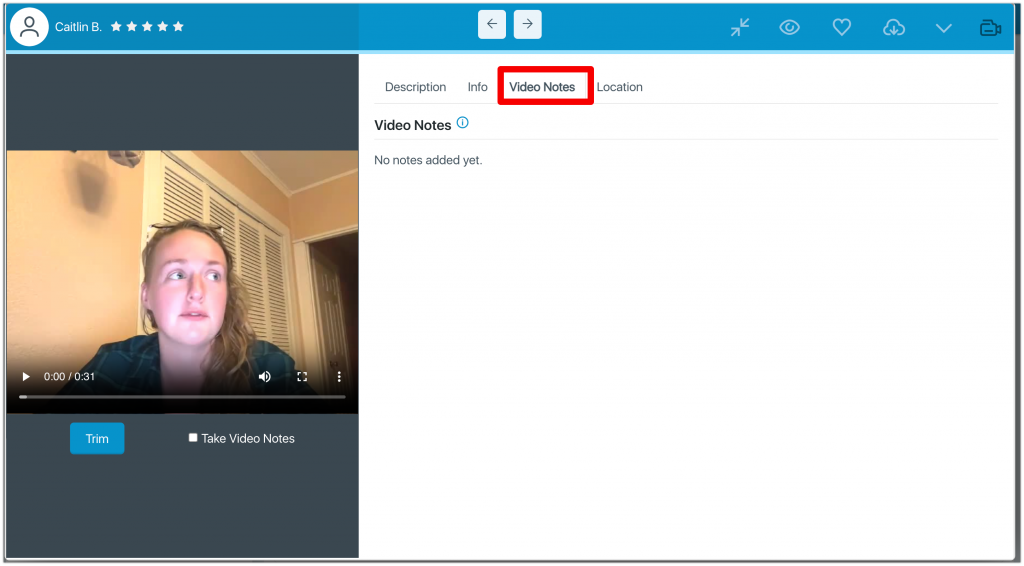
Location Tab: The location tab shows where the participant submitted the entry. Locations only show when ‘capture device GPS location on entries if available’ is selected when creating a new project. It can also be turned on within project settings after the project has been created.
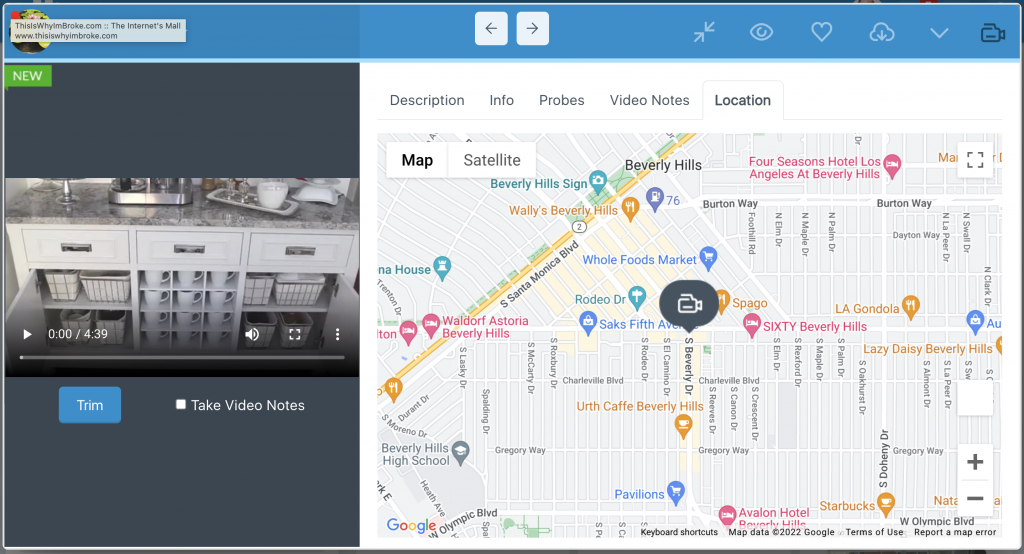
Download: You can download the entry by clicking the download media icon in the top right of an expanded entry.
Delete: You can delete an entry by clicking the dropdown in the top right and clicking the down arrow icon.
Dashboard Filtering
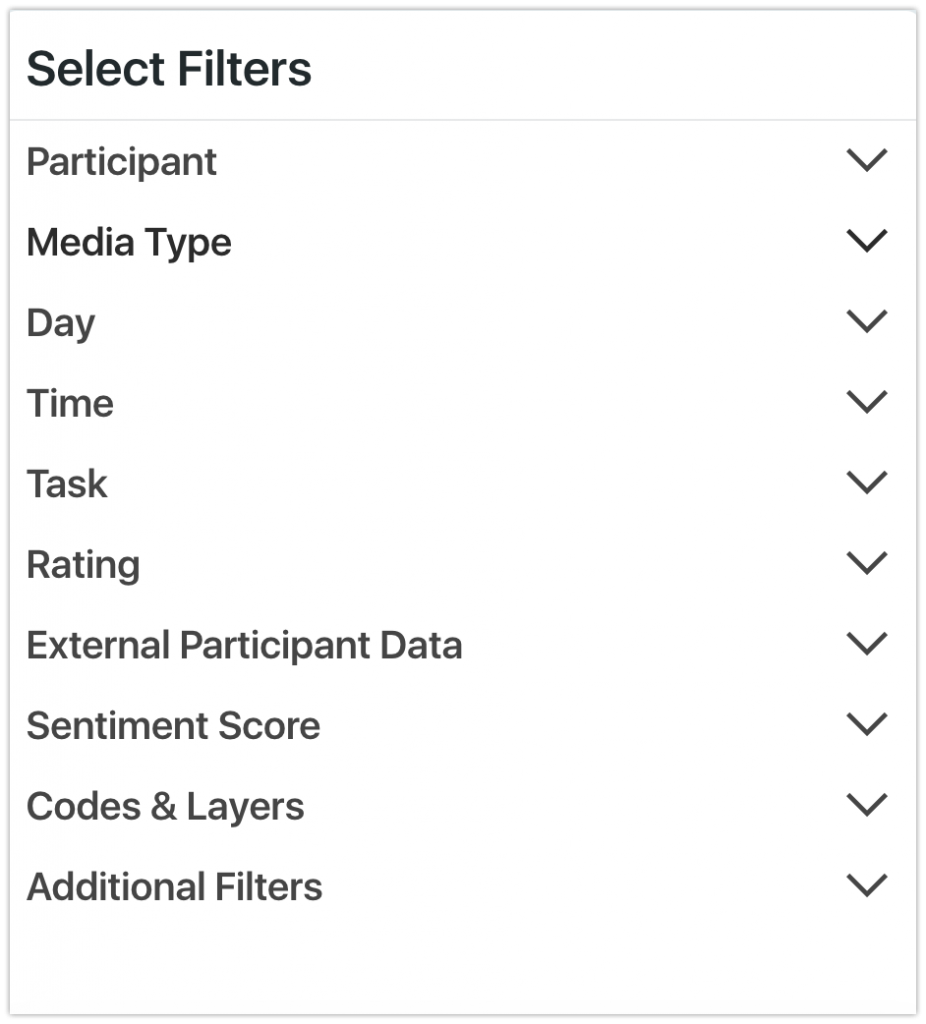
There are several filtering options on the left of the default dashboard view. You can run a filter by selecting the options you want and then clicking apply.
Participant: Allows you to view entries submitted by specific participants.
Media Type: Enhance your search experience by utilizing filters for Audio, Picture, and Video media types. For a more targeted query, especially when seeking out open-ended text, Single Choice, Multiple Choice, Range, or Heat map questions, the Task filter is your go-to
Day: Allows you to filter entries by the day of the week the entry was submitted. Days will only appear if an entry was submitted on that day. Eg, if no participants submit an entry on a Tuesday, Tuesday will not show up as a filtering option.
Time: Allows you to filter entries by time of day. Times will only appear if an entry was submitted during that time frame. Eg, if no participants submit an entry between 10:00 AM – 10:59 AM, 10:00 AM – 10:59 AM will not appear as a filtering option.
Task: Allows you to filter entries by the specific task.
Rating: Allows you to filter by star rating. Star ratings can be adjusted by any manager. Example: If you give an entry a 4-star rating, another manager can change it to 2.
External Participant Data: Allows you to run filters by external participant data if any are present. By default, this will be empty. You can add external participant data through the Admin dropdown in the top navigation. You can also add external participant data through the bulk upload feature on the Participant & User Management page. A tutorial on the page explains this process.
Sentiment Score: You can filter data by overall sentiment score: Positive, Neutral, or Negative.
Codes & Layers: Allows you to run filters by moderator codes that have been added to entries.
Additional Filters:
- Perform and search between codes: This filter is an “and” statement and allows you to search for multiple codes. You would select this option along with at least two codes. For example, if you choose the code “sweet” and then the code “sour” the filter would populate entries that have both of these codes. In comparison, if you were to run a filter that only had a code of “sweet” and a code of “sour” it would populate entries that have either of these codes.
- With Codes: Allows you to see all entries that currently have codes associated with them.
- Without Codes: Allows you to see all entries that have not been coded yet.
- With Notes: Allows you to see all entries that contain moderator notes.
- Without Notes: Allows you to see all entries that do not contain any moderator notes.
Search Bar: Our search functionality supports open-ended text questions and video/audio transcription searches. When you input multiple words in a search, each term is treated independently, yielding results that match any of the terms (an ‘OR’ condition).
Running a Filter: Select all the filtering options you want and click apply at the bottom of the filtering area.